9.3 Body Composition
The body is made up of several different types of tissues that contribute to total body mass. Fat mass is the weight of body fat. The assessment of body composition involves estimating what portion of your total weight is from fat tissue versus lean tissue. Knowing how much body fat you have can be useful when determining your overall likelihood of developing fat-related health disorders. Total body fat consists of both essential and storage fat. Essential fat refers to the minimum amount required for proper physiological functioning and is approximately 5-7% in men and 12-15% in women. Storage fat is how we store extra energy and is composed of subcutaneous and visceral fat. Subcutaneous fat is the layer of fat lying just below the skin and accounts for approximately 70%–80% of total body fat. The quantity of body fat stored in this form can vary substantially. Visceral fat is stored deep in the abdominal and chest cavities, surrounding internal organs.
Although all the U.S. health organizations agree that obesity is unhealthy, they do not all agree on what body fat percentage defines overweight and obesity. The most current proposition is a rating scale similar to that in Table 9.3.
Table 9.3 Body Fat Percentage Ranges
| Rating | Men | Women |
| Essential fat | 5-7 | 12–15 |
| Athletic | 8–12 | 16–20 |
| Fitness | 14–17 | 21–24 |
| Acceptable | 18–25 | 25–31 |
| Overweight/obesity | 25+ | 32+ |
It is important to keep in mind the following points: that all body fat estimates have an inherent error, although obesity increases health risks, some people may not develop obesity-related disorders if they are physically fit and maintain healthy lifestyles and lastly, the location of your body fat is important when considering health implications of body fat.
Body shape, or somatotype, is also useful when discussing body composition. There are three different categories based on somatotype, or body build: endomorph, ectomorph, and mesomorph. Endomorphs are characterized as being stocky with wide hips and a tendency to easily gain body fat, especially visceral fat. Ectomorphs are slightly built with little muscle and fat. This body type often has difficulty gaining and maintaining weight. The mesomorph is usually able to gain muscle easily and does not have high amounts of body fat. Of course, not everyone fits perfectly into one of these categories. However, they can be useful when discussing genetic predisposition and body composition, especially for those struggling with unrealistic goals and expectations.
Methods of Assessing Body Composition
When discussing how body composition is assessed, it is important to understand that no method directly measures body fat. The only way to directly measure body fat is to extract it from all body tissues, which is obviously not possible on living humans. There are a variety of methods of measuring body composition and all have their advantages and disadvantages; some are quick, easy, and relatively inexpensive to administer and some are very complex and quite costly. Each method varies in their accuracy and reliability. All methods estimate or predict body fat from some other measurement and all have an inherent margin of error. Even the most accurate methods have a margin of error of 2-3%. Additional error can be introduced by the subject or technician performing the measurement. What this means is that body composition analysis is not an exact science and should be viewed as a “rough estimate” of percent body fat. This section will discuss four of the most commonly used methods of assessing percent body fat; hydrostatic (underwater) weighing, air displacement plethysmography, bioelectrical impedance analysis, and skinfold measurement.
Hydrostatic (Underwater) Weighing
Underwater weighing is a technique that has been used for decades and was once considered the “gold standard” of assessment methods. It relies on determination of body density to estimate percent body fat. This technique is based on Archimedes’ principle of displacement where submersion in water can be used to determine body volume which can then be used to determine body density. Basically, muscle sinks and fat floats. Therefore, a person with more body fat will weigh less underwater and be more buoyant; and a person with more muscle will weigh more underwater. Buoyancy is used in equations, to determine body volume. Once body volume is determined, it can then be used to estimate body density, and body density can be used to estimate body fat. During the measurement in the water, the subject has to exhale as much air as possible, submerge the body completely, and stay motionless long enough for the technician to get a reading. The reason why the subject has to exhale is to minimize the buoyancy effect of air in the lungs. There will always be a small volume of air left in the lungs that cannot be exhaled. This is referred to as residual lung volume and is factored out in the equations used to estimate body fat.
A common source of error with this method lies in the difficulty with these procedures, especially if the subject is not comfortable in the water. Another source of error is the determination of the volume of air in the lungs or if the subject is unable to exhale down to residual lung volume. The extra air will make the person more buoyant and results in an overestimation of body fat. Other disadvantages are that it is not portable, it is time consuming, and fairly complex.
Air Displacement Plethysmography (Bod Pod)
This newer method is similar to underwater weighing but uses air displacement to determine body density rather than water displacement. The subject sits in a small, airtight container (a “pod”) designed to measure the amount of air they displace. This method is considered to be as accurate as hydrostatic weighing and in many ways it is more advantageous. Its advantages are that it is portable, easy to operate, requires little time, and does not require submersion in water. Disadvantages are that it is costly, the relatively small compartment may not be large enough for bigger subjects and it may cause claustrophobia for some individuals.
Dual X-ray Absorptiometry (DEXA)
A DEXA machine is composed of a scanning table that slides back and forth underneath a mechanical “arm.” This arm sends low-dose focused x-rays into the subject’s body and scans for bone density and fat/lean mass. This is considered the new “gold standard” for assessing body composition because it is the only method that is able to control for bone mineral density. The machine uses an algorithm to provide values for bone density, total fat mass, and total fat-free mass. The results will also show where a subject stores fat and can be useful for monitoring changes in bone mineral density and body composition over time. Advantages of this method are that it is quick and easy for the subject, there is also very little room for technician error, and bone mineral density is controlled for. Disadvantages are that the equipment is expensive, there is potential for accumulated radiation exposure, this is not recommended for pregnant people, and some individuals may be too tall or obese to fit on the table properly.
Figure 9.4 DEXA Scan
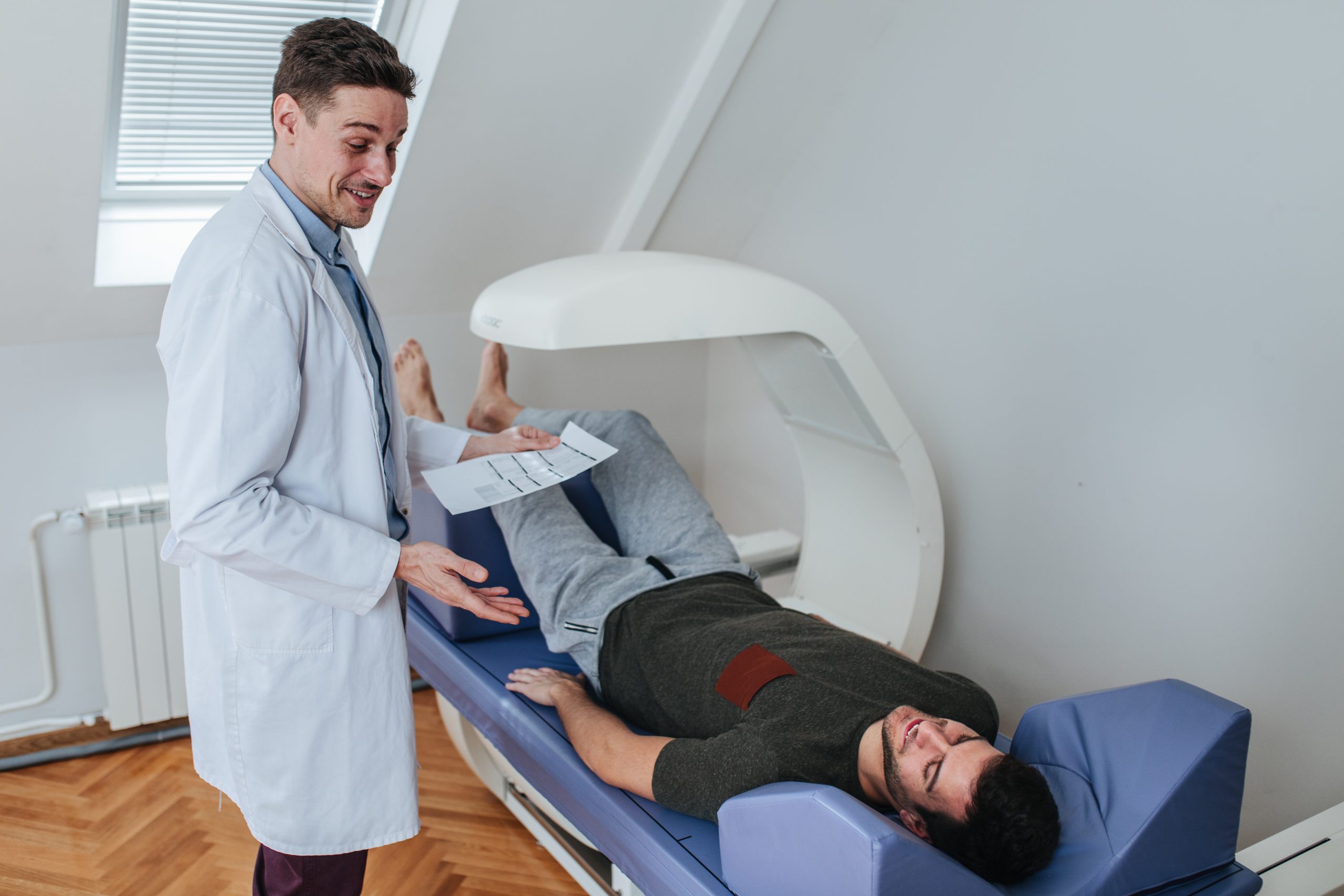
Bioelectric Impedance Analysis (BIA)
The use of bioelectric impedance analysis (BIA) as a method of body fat assessment has increased in popularity in recent years. There are several different BIA machines available to the general public for home use and more sophisticated machines are used in clinical and research settings. BIA is based on the principle that body tissues can be distinguished based on their ability to conduct electrical current. Tissues containing a high water content, such as muscle, conduct electrical current easily whereas tissues with a low water content, such as fat, impede the flow of current. During this method, an insensible electric current is conducted through the body and the impedance to the flow is measured. Computer software then uses prediction equations to estimate the percent body fat from the impedance measures. The commercially available machines do not provide as much accuracy as those used in clinical settings. However, along with body weight, they can be used to monitor changes in body composition over time. Differences in body water content can vary with age, gender, physical activity, and hydration status. Efforts must be made to control any factors that may affect overall hydration of tissues and fluid balance or the accuracy of the results decrease. For this reason, the following pre assessment instructions should be given prior to the measurement taking place:
- No eating or drinking within 4 hr of assessment.
- Avoid moderate or vigorous physical activity within 12 hr of the assessment.
- Abstain from alcohol consumption within 48 hr of the assessment.
- Do not consume diuretic agents, such as caffeine, prior to the assessment.
Figure 9.5 Measuring BIA Using Two Different Devices
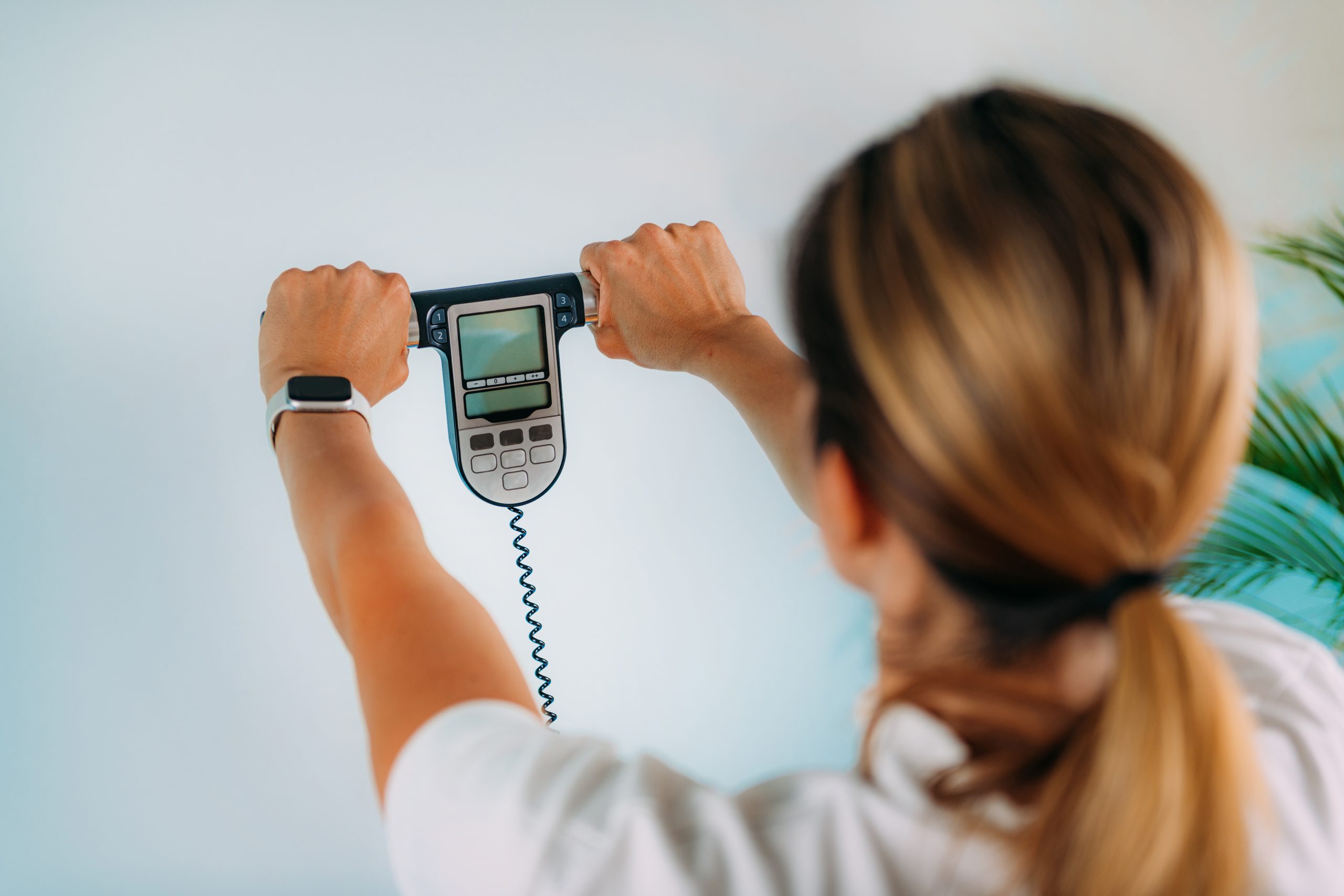
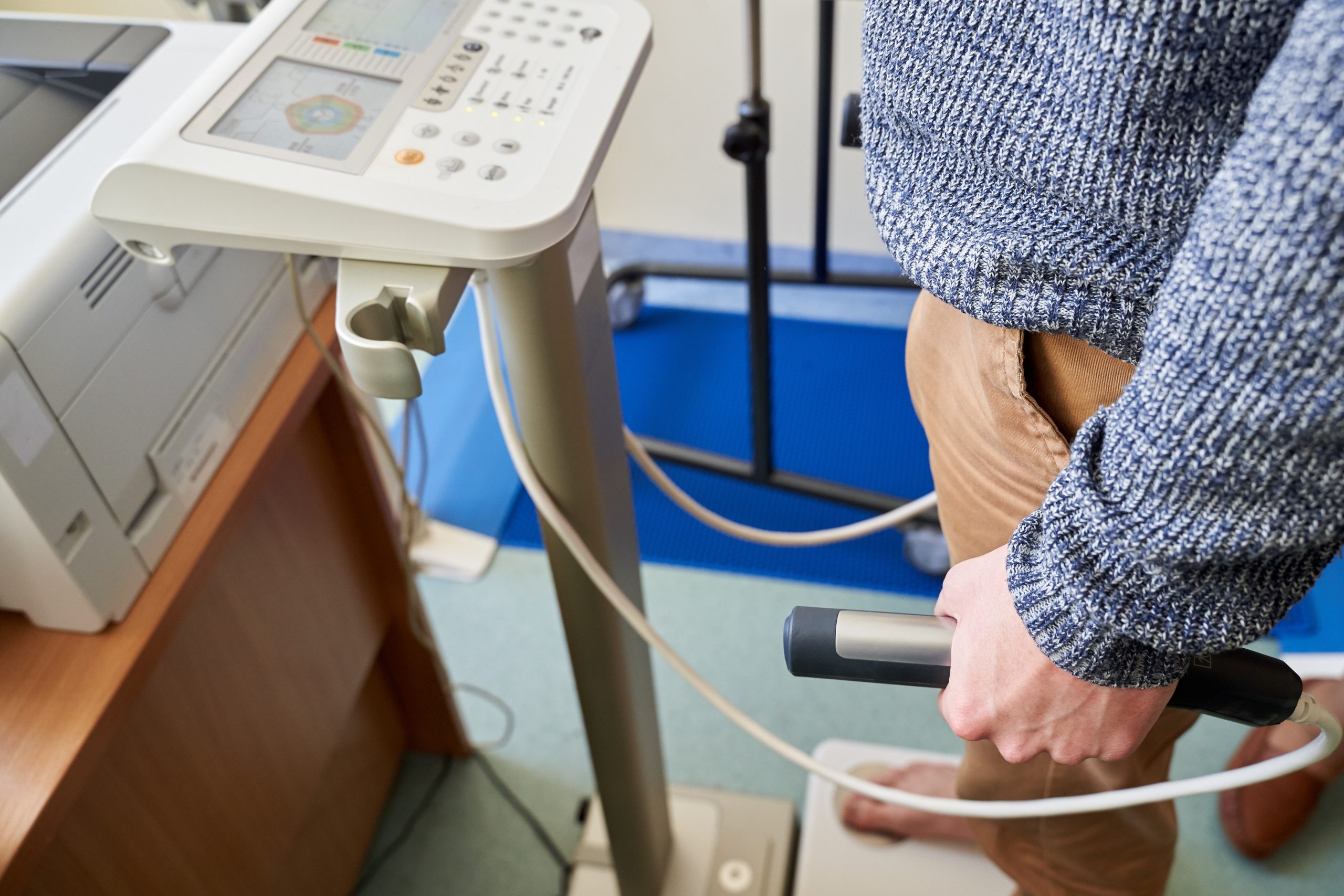
Skinfold Calipers
Skinfold calipers estimate body fat by measuring subcutaneous fat. The thickness of the fat layer, just beneath the skin, is measured using a piece of equipment called a skinfold caliper. The measurements are taken from a variety of body sites in order to improve the accuracy. This method is based on the assumption that the amount of fat underneath the skin is directly related to total body fatness. After measurements are taken, prediction equations are used to estimate body fat. The formula chosen needs to be specific to gender, age, and ethnicity of the subject. Some formulas have also been developed for specific groups of athletes.
When compared to other methods the equipment is relatively inexpensive, it is quick and easy and is very portable. A disadvantage is that it requires a certain amount of privacy because access to some skinfold sites requires partial undressing. Learning how to take skinfold measurement requires proper training and practice. Pinching the skinfold incorrectly, taking measurements at the wrong sites, or placing the caliper incorrectly on the fold can all reduce the accuracy of this method. Therefore, it is important to make sure the technician performing the measurements has been trained sufficiently.
As discussed, many methods can be used to assess percent body fat. Which method you choose depends on cost and availability. Regardless of which method is chosen, the individual should use the same method for subsequent evaluations. It is also important to remember that changes in body composition come slowly and require effort. Body composition analysis is meant to be used to evaluate changes over time, not in the short term.
Figure 9.6 Using Skinfold Calipers on Two Different Sites
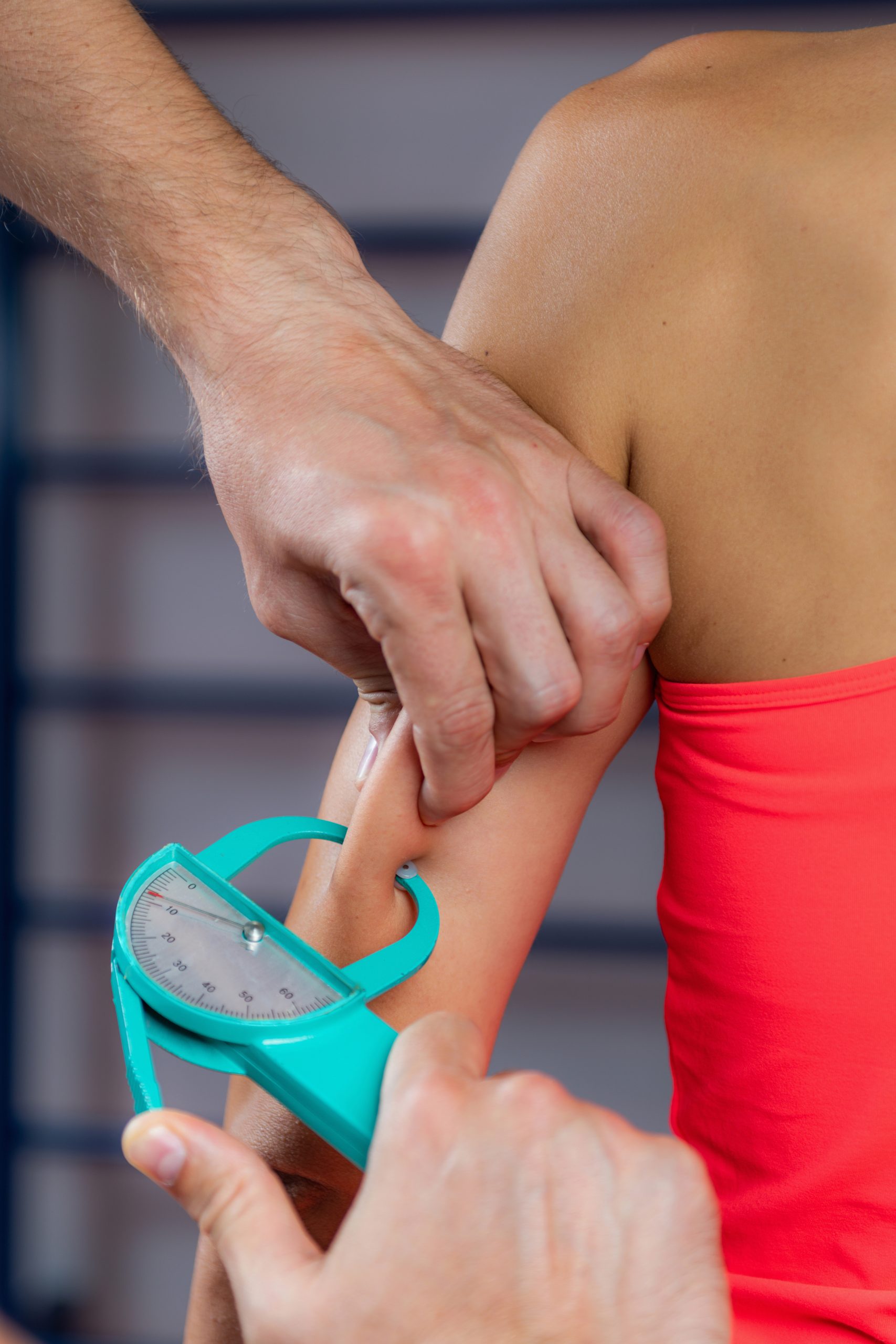
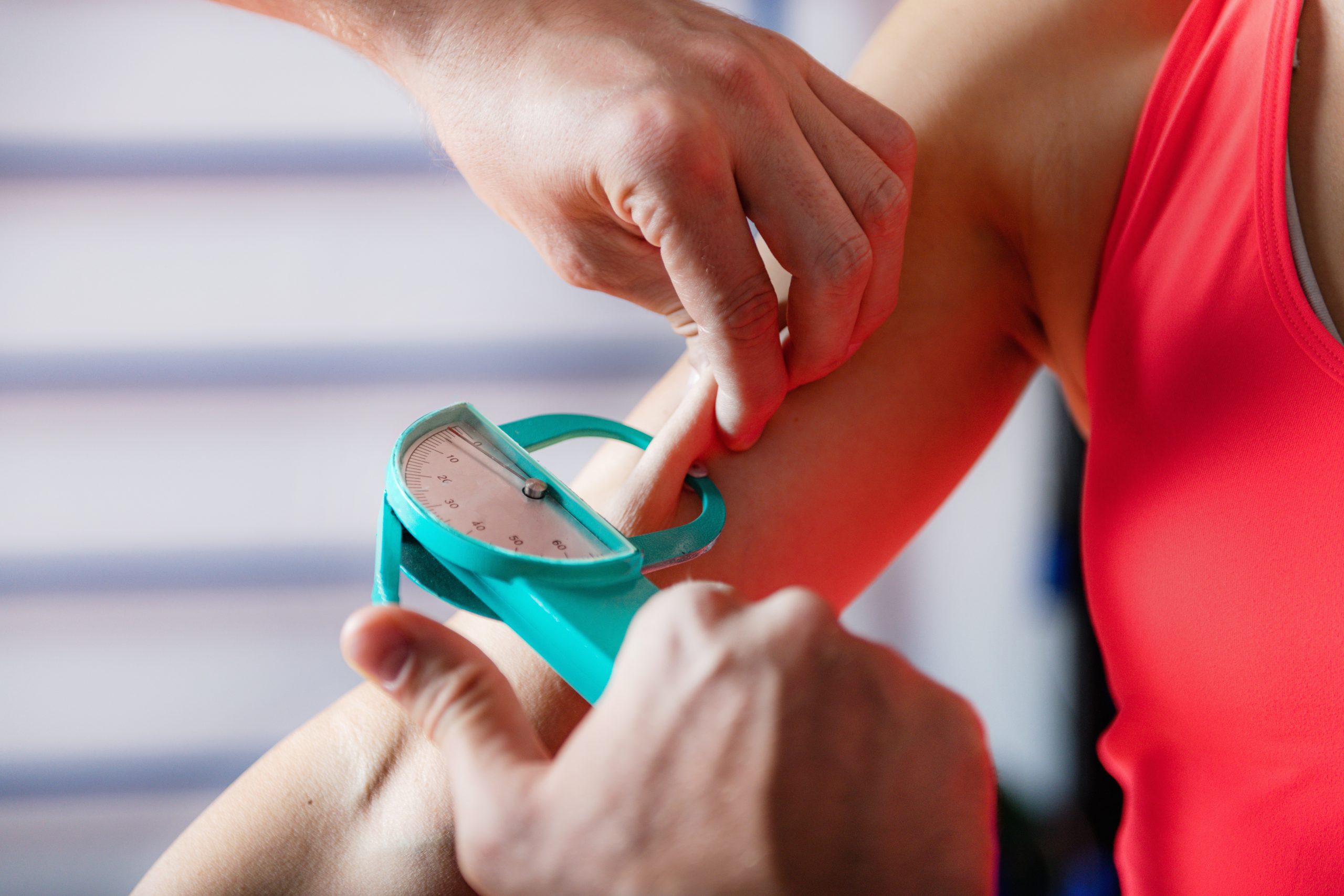
Media Attributions
- DEXA Scan © Adobe Stock is licensed under a All Rights Reserved license
- BIA 1 © Adobe Stock is licensed under a All Rights Reserved license
- BIA 2 © Adobe Stock is licensed under a All Rights Reserved license
- Skinfold Thickness Measurement Triceps © Adobe Stock is licensed under a All Rights Reserved license
- Skinfold Thickness Measurement Biceps © Adobe Stock is licensed under a All Rights Reserved license
